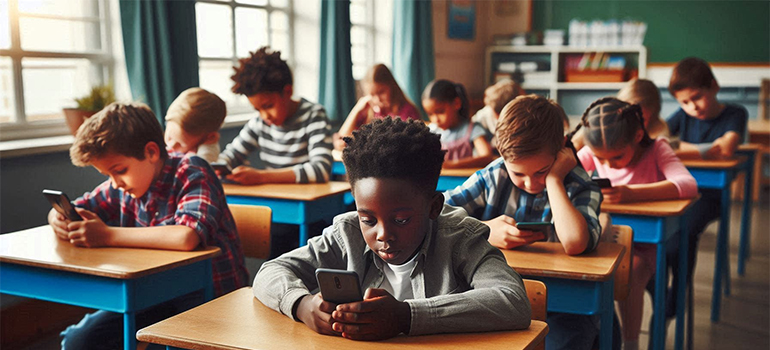
Image Created by Microsoft Copilot (powered by DALL-E)
The debate has been heating up across Canada regarding the use of personal smartphones in schools. This is especially so as many provinces are moving forward with an outright ban on the devices, Ontario being among the latest. Some parents and even students are all for it. Others, however, are pushing back. The question comes down to: do kids really need cell phones at school? Let’s examine the issue.
Why Are Schools Banning Cell Phones?
 It’s no surprise that screen time is becoming a growing issue among kids. According to a 2023 study by the University of Ottawa, 73% of children and youth exceeded screen time recommendations during the height of the COVID-19 pandemic, and this figure has been a tough one to change since then. That not only has negative implications for their mental health, but also results in less physical activity: almost all (96.2%) of children did not meet the 24-hour movement guidelines as a result.
It’s no surprise that screen time is becoming a growing issue among kids. According to a 2023 study by the University of Ottawa, 73% of children and youth exceeded screen time recommendations during the height of the COVID-19 pandemic, and this figure has been a tough one to change since then. That not only has negative implications for their mental health, but also results in less physical activity: almost all (96.2%) of children did not meet the 24-hour movement guidelines as a result.
This extends beyond the home to the school grounds where kids are burying their faces in their phones at recess or pulling them out to message, record, or post during class time. The distraction even between classes, whether it’s at lunch or walking down the hallways, can be detrimental to their focus and attention. This can in turn impact their education and learning.
In Ontario, PPM 128 is the Provincial Code of Conduct, which was updated in April 2024 to include mandates to help keep students focused on learning by removing these distractions. The goal is also to promote positive mental health.
What Are The New Rules?
Schools have advised parents of various new rules. Typically, this includes an outright ban on mobile devices for grade school kids from kindergarten to grade 8 as well as secondary students from grade 9 to 12. While kids can have cell phones on their person or in their belongings, the devices must be turned off or set to silent mode. The phones must also remain out of view at all times. (Note that the rules may vary from one school district or type to the next).
Wearables like smartwatches must also be either off or put into “airplane mode” during the school day. Many kids’ smartwatches come with “school modes” that do just that automatically between certain hours of the day.
There are exceptions, including permission given for health or medical purposes, support for special education needs, or any Human Rights Code-related needs or circumstances; or if the device is necessary for learning. (For example, my son created stop-motion videos for a project last year where his phone was permitted for use during the class periods so he could access a specific app).
If a student is found using their device, they may be required to hand it over to the school or store it in a safe place for the remainder of the day.
The Debate About Cell Phones in Schools
![]() This sounds like a positive step in the right direction towards helping kids retain their focus in school without distractions. Many parents agree. After all, we didn’t have cell phones in school and did just fine. Of course, that was also a different time.
This sounds like a positive step in the right direction towards helping kids retain their focus in school without distractions. Many parents agree. After all, we didn’t have cell phones in school and did just fine. Of course, that was also a different time.
Parents who argue that their kids need to reach them may be perpetuating the problem. The trust should be placed in the school when kids are there. If there’s an issue, the office can call home to advise. If it’s an emergency, the parents can contact the school to get in touch with their child.
Some argue that their kids need their phones to walk to and from school, or for older kids, for monitoring and safety when they head out for lunch. These new rules, however, do not impact that. A student can use their phone on the way to the school grounds and once leaving them. It’s also technically permitted once the school bell rings at the end of the day. The only time it isn’t is during class time and active school hours while on school property.
For kids who have cell phones, they should be mindful of the rules and flip their devices to silent mode when they arrive at school and turn it back on any time they leave school grounds (with permission to do so). If kids are unable to follow these rules, it’s an indication that they aren’t responsible enough to own a cell phone in the first place.
A Happy Medium
The bottom line is that there’s no logical reason for a child to need a cell phone while in school, and they should not get into the habit of relying on one. School should be a time for a digital disconnect beyond the technology provided for the purposes of education, like a Chromebook or even tablet.
With that said, the best schools and teachers will use logical reasoning with these rules. If the child needs to record video for a project, for example, and their cell phone is the ideal method, they should be permitted to do so. Video can still be recorded while the phone is in airplane mode. If the child needs an important password that’s stored on their phone, let them grab the phone to access it, then put it away once done. The use can be monitored and if they are found accessing other apps or software that go beyond the scope of their project, this can be handled on a case-by-case basis.
If parents choose to allow their kids to use cell phones, this comes with a level of responsibility. The onus is on the schools to ensure kids follow these rules while they’re there. But parents need to instill the proper values and habits with their kids before giving them this form of independence at all.
Smartphones can be a useful tool, but they can also become addictive. If there’s any signs of the latter, the solution may be taking the phone away, or not allowing the kids to bring them into the schools at all. With a happy medium, older students can afford all the benefits owning a cell phone can provide while still respecting the importance of education and shutting down social media and recreational uses when appropriate.
-30-
More about school tech
WIN a Pinwheel Plus 3 Kids Unlocked Smartphone with 1 year parent controls/dashboard monitoring. Total prize value $709
Check out our contests and enter for your chance to WIN cool tech prizes!



